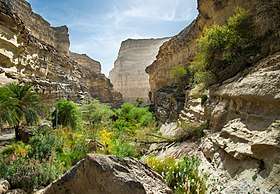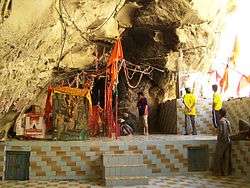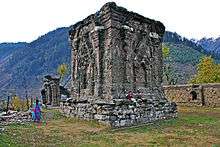Hinglaj Mata
| Hinglaj Mata ہنگلاج ماتا | |
|---|---|
 Hinglaj goddess at Hinglaj Mata Mandir | |
| Geography | |
| Coordinates | 25.0°30′50″N 65.0°30′55″E / 25.51389°N 65.51528°E |
| Country |
Pakistan |
| State | Balochistan |
| District | Lasbela District |
| Locale | Hinglaj |
| History | |
| Website |
www |
Hinglaj Mata (Balochi and Urdu: ہنگلاج ماتا), also known as Hinglaj Devi, Hingula Devi and Nani Mandir, is a Hindu temple in Hinglaj, a town on the Makran coast in the Lasbela district of Balochistan, Pakistan, and is the middle of the Hingol National Park. It is one of the Shakti Peethas of the Hindu goddess Sati.[1] It is a form of Durga or Devi in a mountain cavern on the banks of the Hingol River.[2] Over the last three decades the place has gained increasing popularity and became a unifying point of reference for Pakistan's many Hindu communities.[3]
Location

The cave temple of Hinglaj Mata is in a narrow gorge in the remote, hilly area of Lyari Tehsil in Pakistan's Balochistan province. It is 250 kilometres (160 mi) to the northwest of Karachi, 12 miles (19 km) inland from the Arabian Sea and 80 miles (130 km) to the west of the mouth of the Indus. It is at the end of a range of Kheerthar hills, in the Makran desert stretch, on the west bank of Hingol River.[4][5] The area is under the Hingol National Park.[6]
The shrine is in a small natural cave. There is a low mud altar. There is no man-made image of the goddess. A small shapeless stone is worshiped as Hinglaj Mata. The stone is smeared with Sindoor (vermilion), which possibly gives the location its Sanskrit name Hingula, which is the root of the present-day name Hinglaj.[5]
Other places of worship in and around Hinglaj are Ganesh Deva, Mata Kali, Gurugorakh Nath Dooni, Braham Kudh, Tir Kundh, Gurunanak Kharao, Ramjarokha Bethak, Aneel Kundh On Chorasi Mountain, Chandra Goop, Khaririver and Aghore Pooja.[6]
Significance
_During_Yanglaj_Yatra_2017_Photo_by_Aliraza_Khatri.jpg)
_During_Yanglaj_Yatra_2017_Photo_by_Aliraza_Khatri.jpg)
Hinglaj Mata is said to be very powerful deity who bestows good to all her devotees. While Hinglaj is her main temple, temples dedicated to her exist in neighbouring Indian states Gujarat and Rajasthan.[7] The shrine is known as Hingula, Hingalaja, Hinglaja, and Hingulata in Hindu scriptures, particularly in Sanskrit.[8] The goddess is known as Hinglaj Mata (the Mother Hinglaj), Hinglaj Devi (the Goddess Hinglaj), Hingula Devi (the red goddess or the Goddess of Hingula)[5] and Kottari or Kotavi.[9]
The chief legend of Hinglaj Mata relates to the creation of the Shakti Peethas. The daughter of Prajapati Daksha, Sati was married to the god Shiva against his wishes. Daksha organized a great yajna but did not invite Sati and Shiva. Uninvited, Sati reached the yajna-site, where Daksha ignored Sati and vilified Shiva. Unable to withstand this insult, Sati immolated herself activating her chakras, (energy generated through her anger).
Sati died, but her corpse did not burn. Shiva (as Virabhadra) slew Daksha for being responsible for Sati's death and forgave him, resurrecting him. The wild, grief-stricken Shiva wandered the universe with Sati's corpse. Finally, the god Vishnu dismembered the body of Sati into 108 parts, from which 52 fell on earth and others on other planets in the universe which became Shakti Peethas, temple to a form of the Goddess.
Shiva is also worshiped at each Shakti Pitha in the form of Bhairava, the male counterpart or guardian of the presiding goddess of the Pitha.[10] The head of Sati is believed to have fallen at Hinglaj.[6][11][7]
The Kularnava Tantra mentions 18 Pithas and mentions Hingula as the third one. In the Kubjika Tantra, Hingula is listed among the 42 Shakta or Siddha Pithas in which Hinglaj is at the fifth place.[12] The Pithanirnaya or Mahapithanirupana section from the Tantrachudamani originally listed 43 names, but names were added over time making it 51 Pithas. It details the Pitha-devata or Devi (name of goddess at the Pitha), the Kshastradishas (Bhairava) and the anga-pratyanga (limbs including ornaments of Sati). Hingula or Hingulata is the first in list, with the anga-pratyanga being Brahmarandhra (a suture in the crown of the head). The Devi is known by several names such as Kottari, Kottavi, Kottarisha, and the Bhairava is Bhimalochana.[13] In the Shivasharitha, Hingula is again the first in a list of 55 Pithas. Brahmarandhra is the anga-pratyanga, the goddess is called Kottari and the Bhairava is Bhimalochana (located in Koteshwar).[14]
In the non-scripture 16th century Bengali work Chandimangal, Mukundaram lists nine Pithas in the Daksha-yajna-bhanga section. Hinglaja is the last Pitha described to be the place where Sati's navel fell.[15]
Another legend narrates that Hingol and Sundar, sons of Vichitra who lived in the Treta yuga (second of four Hindu eons), tormented the people. To free the people from their tyrant, the god Ganesha slew Sundar. Then, the people prayed to Devi (the Hindu Goddess) to kill Hingol as well, which she agreed to do. She followed Hingol to the cave, which is currently the Hinglaj Mata shrine. Before he was killed, Hingol requested the goddess to name the place after him, which she granted.[7]
Another legend is related to the caste Brahmakshatriya, who venerate Hinglaj Mata as their family deity. When the god Parashurama was persecuting kshatriyas (the warrior caste), some Brahmins (priest caste) provided protection to 12 kshatriyas and disguised them as Brahmins, and they were also protected by Hinglaj Mata. This caste traces its roots to the Brhmakshatriyas. Another variation of the tale is that the sage Dadhichi provided protection to Ratnasena, a king ruling in Sind, in his ashram (hermitage). However, Parashurama killed him when he ventured out. His sons remained in the ashram. When Parashurama visited the ashram, they were disguised as Brahmins. One of them, Jayasena, returned to Sind to rule the kingdom, armed with a protective mantra of Hinglaj Mata, given by Dadhici. Hinglaj Mata protected Jayasena and ordered Parshurama to end his killing spree.[7]
The local Muslims also hold Hinglaj Mata in reverence and provide security to the shrine. They call the temple the "Nani Mandir" (lit. "maternal grandmother’s temple").[16] The goddess is herself called Bibi Nani (respected maternal grandmother). Bibi Nani may be the same as the goddess Nana, that appears on Kushan coins and was widely worshiped in West and Central Asia.[9][17] Local Muslim tribes, following an ancient tradition, join the pilgrimage group and call the pilgrimage the "Nani Ki Haj".[1]
Annual pilgrimage

The annual four-day pilgrimage to the Hinglaj Mata Temple is in April. The major ceremony in the pilgrimage occurs on the third day, when the priests of the shrine recite mantras to invoke the gods to accept the offerings brought by the pilgrims, and bless them.[4] Offerings made by the pilgrims to the deity primarily consist of three coconuts.[11] While some remain in Hinglaj for all four days, others make a short day trip.[18]
Pilgrimage to the site is traditionally begun from the Nanad Panthi Akhada in Karachi. The pilgrim groups are headed by a holy staff bearer called the chaadiar, authorized by the Akhada (a Hindu organization of sadhus). The sadhus (holy-men) belonging to this group are a very cohesive group of Hata yogis with ancestral genealogy of their own; and they also observe secret rites.[1]
Pilgrims from all over Pakistan and even India visit the temple,[19] holding traditional red banners and wearing red-gold decorative head-scarves, which are associated with sanctuaries of Hindu goddesses, in this case Hinglaj Mata. What was once a journey of more than 150 kilometres (93 mi) by foot through the desert from the nearest road, is now made easy by the Makran Coastal Highway connecting Karachi with Gwadar. Hinglaj is 328 km and nearly 4 hours drive from Karachi on the Makran Coastal Highway. Consequently, the number of pilgrims visiting the shrine has substantially increased over the years; the last reported figure was 25,000 to 30,000. While most pilgrims come by buses or private cars, a few cycle their way to the shrine, as it is believed that more the austerities, the more is the grace of the deity.[18][20][21][3]
Before the independence of India and Pakistan in 1947, the region constituting present-day Pakistan had 14% Hindu and Sikh population, which fell to 1.6% or about 3 million due to migration of 6 million Hindus and Sikhs to India.[22] Of these, nearly 2.3 million Hindus, the largest concentration is in a single district: Tharparkar District (Thar) district of Sindh Province. They form the largest contingent of pilgrims to Hinglaj Mata Temple. They include merchants, government servants, but the majority are the lower-class Hindus, serving as bonded labourers and farm workers. The costumes of these folks from rural Pakistan are most colourful. Their women dress in heavily embroidered clothes with bangles adorning their wrists. For Thari children employed as bonded labour, this is a one-time fun time. The pilgrims include middle-class Hindus, especially from nearby Karachi, which is a stop on the pilgrimage route to Hinglaj.[18][23][24]
The pilgrimage serves as meeting point for places and doing community activity like gathering funds for construction of a Hindu temple.[16] Hundreds of volunteers help in the organization. Diesel generators are installed. Vast community kitchens are set up to cook food prepared with tonnes of food stuff such as wheat floor, rice, lentils, and vegetables supplied by local people to feed the pilgrims. Three meals are prepared.[25] Temporary bathroom facilities and camps are installed.[18]
Kuldevi
Hinglaj Devi worshiped as Kuldevi (family or caste deity) of Bhawsar(Bhavsar) samaj, Brhamkshatriya samaj (Hindu Khatri) Barot (caste)
As per the popular folklore of Treta Yuga, a virtuous Haihaya king of Mahishmati of Malwa region, Sahastrabahu Arjuna or Sahastararjun, more widely known as Kartavirya Arjuna drunk with power and sense of invincibility ends up killing the great Brahman sage Jamadagni over a sacred cow Kamadhenu. Furious at this heinous crime, son of Jamadagni, Lord Parashurama vows to vanquish the power-drunk Kshatriya clan from Earth. Wielding his divine AXE, he eliminates Sahastararjun and later on he rages on earth 21 times, each time decimating unvirtuous and unworthy kings wherever he went.
Terrified with the prospect of death at Lord Parashuram, the progeny of Sahastararjun seek Janaka Maharaj, one of the most learned king of Videha who advises them to seek Hinglaji Mata's blessing. The clan devotedly pray to Devi at Higloj who is overcome with compassion and assures shelter in her place. Over time, when Lord Parashuram visits this place, he was pleasantly surprised to see Kshatriya clan involved in many Brahminical activities having shed their arms. Hinglaj Mata intervenes on their behalf, and since then the clan disowned arms. Lord Parashuram not only taught them scriptures and Vedas, but also weaving for a living. The clan with a sense of relief then branches out and spread across Sindh, Panjab, Rajasthan, Madhya Pradesh, and later on to South India, such as Maharashtra, Telangana, Andrapradesh and Karnataka. And where ever they went they continued worshiping Hinglaj Devi. Bhavasars, Barot (caste), Shimpis and Khatris of Somavaunsha Sahasrarjun Kshatriya trace their origin to this clan. Some of those who remained in Sindh province later on converted to Islam. Of note, even to they are one of the oldest non-Brahmin clans who had knowledge of Vedas. To this day many works as weavers and tailors.[26]
Amba Bhavani or Jagadamba is considered as one of the later incarnations of Hinglaj Devi by the same communities who also worship her mostly in Western India.
See also
References
- 1 2 3 Raja 2000, p. 186.
- ↑ Dalal 2011, pp. 158-59.
- 1 2 Schaflechner, Jürgen, (2018). Hinglaj Devi : identity, change, and solidification at a Hindu temple in Pakistan. New York, NY: Oxford University Press. ISBN 9780190850555. OCLC 1008771979.
- 1 2 "In pictures: Hindus in Pakistan". Prayers offered. British Broadcasting Corporation. Retrieved 26 November 2012.
- 1 2 3 Kapoor 2002, pp. 2988-90.
- 1 2 3 "Socio - Ecological and Economic Impacts of Hinglaj Mata Festival on Hingol National Park and its Resources". Scribd.com. Retrieved 27 November 2012.
- 1 2 3 4 Dalal 2011, pp. 158-9.
- ↑ Sircar 1998, p. 113.
- 1 2 Sircar 1998, p. 43.
- ↑ Jones, Constance; Ryan, James D. (2007). Encyclopedia of Hinduism. Infobase Publishing. pp. 401–402. ISBN 9780816075645. Retrieved 14 November 2012.
- 1 2 "In pictures: Hindus in Pakistan". Offerings. British Broadcasting Corporation. Retrieved 26 November 2012.
- ↑ Sircar 1998, pp. 18-19.
- ↑ Sircar 1998, p. 35.
- ↑ Sircar 1998, p. 39.
- ↑ Sircar 1998, pp. 32-3.
- 1 2 "In pictures: Hindus in Pakistan". Priests. British Broadcasting Corporation. Retrieved 26 November 2012.
- ↑ Kapoor 2002, pp. 2989-90.
- 1 2 3 4 "In pictures: Hindus in Pakistan". Karachi Hindus. British Broadcasting Corporation. Retrieved 26 November 2012.
- ↑ Being In The World Productions, ON BECOMING GODS (Pakistan 2011, 44min), retrieved 2018-08-07
- ↑ "In pictures: Hindus in Pakistan". Growing popularity. British Broadcasting Corporation. Retrieved 26 November 2012.
- ↑ "In pictures: Hindus in Pakistan". Cyclists. British Broadcasting Corporation. Retrieved 26 November 2012.
- ↑ "In pictures: Hindus in Pakistan". Old and young. British Broadcasting Corporation. Retrieved 26 November 2012.
- ↑ "In pictures: Hindus in Pakistan". Tharis. British Broadcasting Corporation. Retrieved 26 November 2012.
- ↑ "In pictures: Hindus in Pakistan". Children's paradise. British Broadcasting Corporation. Retrieved 26 November 2012.
- ↑ "In pictures: Hindus in Pakistan". Collective effort. British Broadcasting Corporation. Retrieved 26 November 2012.
- ↑ http://www.sskna.org/newsite/folklores.php
Bibliography
- Raja, Prajna; Raja, Harish (2000). Prajna Yoga. Ocean Books (P) Ltd. p. 186. ISBN 81 87100-50-8.
- Kapoor, Subodh (2000). The Indian Encyclopaedia: Biographical, Historical, Religious, Administrative, Ethnological, Commercial and Scientific. Hinayana-India (Central India). Genesis Publishing Pvt Ltd. p. 2989. ISBN 9788177552676.
- Sircar, Dinesh Chandra (1998). The Śākta Pīṭhas Volume 8 of Religion and Ethics Series. Motilal Banarsidass Publ. pp. 18–19, 35, 39. ISBN 9788120808799.
- Dalal, Roshen (1998). Hinduism: An Alphabetical Guide. Penguin Books India. pp. 158–59. ISBN 9780143414216.
